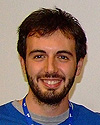Angelo Di Canto wins 2013 URA Thesis Award
 |
|
Angelo Di Canto
|
Angelo Di Canto has been fascinated by physics since he was young. He first came to Fermilab in 2006 as a summer undergraduate intern to begin learning how to do high-energy physics research.
Di Canto, now a postdoctoral scholar at the University of Heidelberg in Germany, won this year's URA Thesis Award for his work with charmed meson decay using CDF data taken at Fermilab.
Di Canto first started working on charmed meson decay as a Ph.D. student in 2009 at the University of Pisa. His thesis focused on searching for charge-parity violation in decays of charmed mesons. CP violation would show that charmed mesons and their antiparticles didn't behave the same way when their charge and orientation were reversed in space.
At that time, CDF data contained information on charmed mesons but it couldn't be extracted in an efficient fashion. Di Canto's thesis outlined a method to precisely measure and assess CP violation using tight controls on uncertainties and data collected from the Tevatron runs from 2002 to 2010.
"For the first time, we were able to measure these quantities to the precision that is actually needed to start probing many aspects of the Standard Model and seeing if new physics might appear," Di Canto said.
Di Canto's thesis was one of 17 nominees for the award.
"Measurements of the asymmetry using decay into pions and particularly kaons had never been made with comparable precision and control of systematics," said Robert Zwaska, URA thesis committee chair. "Angelo had to do a lot of that work by himself, which speaks to the amount of intellectual involvement he had in it."
CP violation in particles is important because it helps scientists understand the behavior of matter and antimatter and how it fits into the bigger picture of the universe, Zwaska said.
Charmed mesons, Zwaska said, are an "untapped area." Because charmed mesons are almost always found in regimes with many other particles with similar masses and properties, extracting that data can be difficult.
Zwaska also said that the quality of Di Canto's thesis in terms of writing and clarity stood out among the others.
"The award came as a surprise for me, but I was excited and happy to receive it," Di Canto said.
The judges focused on clarity, originality and physics content in their decisions, Zwaska said.
"The URA Thesis Award conferred on Angelo Di Canto recognizes both his outstanding work and the vital role that Fermilab plays in the education and training of young scientists," said Marta Cehelsky, executive director of URA.
—Sarah Khan
|